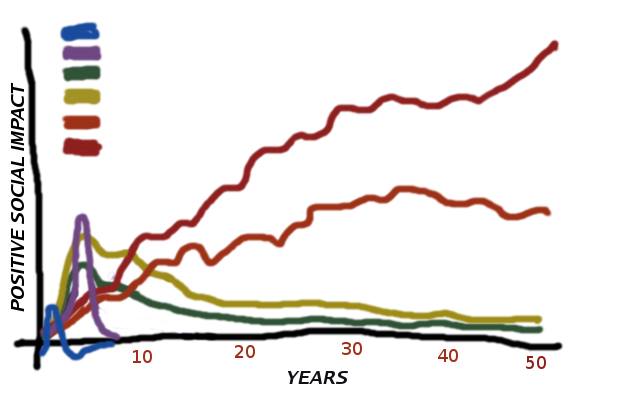Some months ago, I attempted to conceptualize, in data-visualized form although still a kernel, of what I’ve been trying to jot down as raw notes for a blog piece. But since then, I haven’t had the chance to sit down to complete the piece.

Thus, you people are stuck with the same raw graph I posted last May. I’m sure you are curious as to what the squiggly lines of different colors represent. Let this be a little exercise for interested readers to complete the concept, without my having to launch into treatise mode.
The short quirky blue line represents minor, transient fads that emerge from super-elitist (or cultist, or high-geek) subcultures. Think of 4chan and 9gag memes, viral videos, and silly catchwords. These fads enjoy a flashpan popularity for a year or so (or even less), develop different strains, then sink back to subculture or cultist level — often in mutated forms, exactly like viruses.
The purple line, on the other hand, represents major fads or fashions that endure better and eventually help define the “lifestyle” of a generation. Think of the 1960s hippie and the 1970s symbols of social rebellion. There are hybrid types between blue and purple.
The green line is what I like to call “personal tokenism”. This is a very important social squiggle, so I’m devoting many paragraphs to describe it.
Green-liners are individuals, households, or small groups that adopt new positive practices on their own: they avoid plastic, save water, install solar power on the rooftop, go organic, practice charity, not be involved in corruption, etc.
Green-liners and their personal tokenism are serious about lifestyle change, and are contemptuous of those who treat these as mere fads or fringe cultures. Often, they were radical activists in their youth, and want to continue being relevant despite having mellowed into comfortable middle-class existence.
They hope that their personal crusades and new practices will snowball until their advocacy changes the whole of society. They want to mainstream and institutionalize their ideas. And they do make some dents insofar as they teach their children, hold classes, write articles, become successful NGO leaders.
But they refuse to (or don’t know how to) analyze and tackle the systemic roots of the problem. They avoid confrontational politics and militant mass movements. They might see the general need to change the system, but they don’t want the messiness of revolution. So in the long run, they just continue to nibble at the easily chewable parts of the problem and are content with the token successes of their advocacies.
The yellow line is somewhat similar to the green line. The difference is that the new positive practices are adopted/coopted, or initiated/sponsored by the state. This is not necessarily bad. In fact, the presumption is that it’s good because it means the positive practices are systematized and institutionalized, to benefit the present and current generations. But it also opens up possibilities of such practices being distorted and abused.
Much depends actually on the character of the government that absorbs yellow liners. If it’s truly democratic, grassroots-based, and enjoys popular support, then the green and yellow lines create synergies. This opens up new trajectories based on the principle of mass undertaking — similar to the orange and red lines.
But if the government is elitist, corrupt and repressive, then the fresh sprouts of reform and innovation are made to languish and eventually suffocate and die (or mummify) in the maze of bureaucracy and official hypocrisy. Thus the trajectory of diminishing returns for the people after 5-10 years, which is the usual pace of the rich/bureaucratic elite adjusting to new rules of the game. This yellow line is classic reformism.
This entire graph was intended to end with the question, “What squiggly color are you?” But this is neither a quiz nor a treaty, neither a listicle nor a new communist manifesto. It is just an idle rambling of one person who, while on travel duty, debated with himself whether to enjoy a long warm shower because the hostel was already paid for, anyway, or to keep it short and snappy because water saved is water saved, whether you paid for it or not.
I leave you to guess what is meant by the orange and red lines. But if you get my drift, you will also understand why the looming social revolution will not be tweeted. # Follow @junverzola

